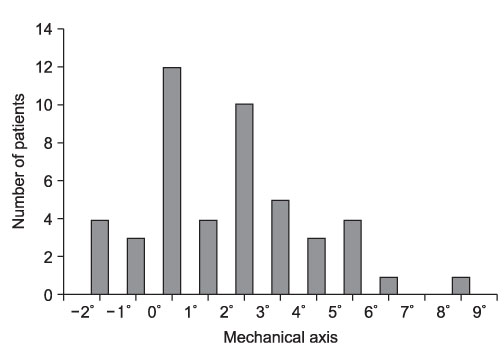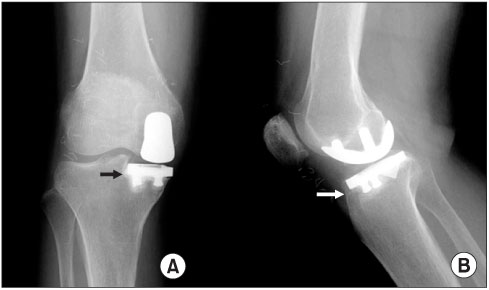J Korean Orthop Assoc.
2010 Dec;45(6):426-432. 10.4055/jkoa.2010.45.6.426.
Short-Term Outcomes of Miller Galante(R) Fixed-Bearing Unicondylar Knee Arthroplasty: A Comparative Study in Outcomes according to Postoperative Correction Angle
- Affiliations
-
- 1Department of Orthopedic Surgery, Center for Joint Disease, Chonnam National University Hwasun Hospital, Jeonnam, Korea. eksong@jnu.ac.kr
- KMID: 2185489
- DOI: http://doi.org/10.4055/jkoa.2010.45.6.426
Abstract
- PURPOSE
To evaluate short-term clinical and radiographical results of fixed bearing unicondylar knee arthroplasty (UKA) comparing results between over-corrected group and under-corrected group.
MATERIALS AND METHODS
Clinical and radiographical outcomes of 47 Miller-Galante(R) UKAs with a minimum of 4-year follow-up were evaluated. We also compared both clinical and radiographical results between over and under corrected groups, which were divided by 2degrees varus of mechanical axis postoperatively.
RESULTS
HSS and WOMAC scores improved from 75.4 and 57.7 preoperatively to respectively, 95.2 and 12.1 at the last follow up. Radiographically, the mechanical axis changed from 7.2degrees varus preoperatively to 2.8degrees varus at the last follow-up. A partial radiolucent line on the medial side of the tibia was observed in 23% of the 47 cases. Degenerative changes in the lateral compartment and the patellofemoral joint were observed, respectively, in 23% and 26%. There were no significant differences between the two groups in clinical and radiographical results (p>0.05). In the undercorrected group, three cases converted to total knee arthroplasty because of medial tibial collapse.
CONCLUSION
Miller-Galante(R) UKA showed good outcomes in short-term follow-up with the exception of three failures. There were no significant differences between more than 2degrees varus corrected and under 2degrees varus corrected groups in clinical and radiographical results. However, all 3 conversions to total knee arthroplasties occurred in the undercorrected group.
Figure
Reference
-
1. Chassin EP, Mikosz RP, Andriacchi TP, Rosenberg AG. Functional analysis of cemented medial unicompartmental knee arthroplasty. J Arthroplasty. 1996. 11:553–559.
Article2. Swank M, Stulberg SD, Jiganti J, Machairas S. The natural history of unicompartmental arthroplasty. An eight-year follow-up study with survivorship analysis. Clin Orthop Relat Res. 1993. 286:130–142.3. Insall J, Aglietti P. A five to seven-year follow-up of unicondylar arthroplasty. J Bone Joint Surg Am. 1980. 62:1329–1337.
Article4. Laskin RS. Unicompartmental tibiofemoral resurfacing arthroplasty. J Bone Joint Surg Am. 1978. 60:182–185.
Article5. Choy WS, Kim KJ, Yang DH, Lee HH, Kim HY. Early results of mobile bearing unicompartmental knee arthroplasty in Korean patients. J Korean Orthop Assoc. 2006. 41:826–833.
Article6. Price AJ, Webb J, Topf H, Dodd CA, Goodfellow JW, Murray DW. Oxford Hip and Knee Group. Rapid recovery after oxford unicompartmental arthroplasty through a short incision. J Arthroplasty. 2001. 16:970–976.
Article7. Berger RA, Nedeff DD, Barden RM, et al. Unicompartmental knee arthroplasty. Clinical experience at 6- to 10-year followup. Clin Orthop Relat Res. 1999. 367:50–60.8. Gleeson RE, Evans R, Ackroyd CE, Webb J, Newman JH. Fixed or mobile bearing unicompartmental knee replacement? A comparative cohort study. Knee. 2004. 11:379–384.
Article9. Li MG, Yao F, Joss B, Ioppolo J, Nivbrant B, Wood D. Mobile vs. fixed bearing unicondylar knee arthroplasty: a randomized study on short term clinical outcomes and knee kinematics. Knee. 2006. 13:365–370.
Article10. Squire MW, Callaghan JJ, Goetz DD, Sullivan PM, Johnston RC. Unicompartmental knee replacement. A minimum 15 year followup study. Clin Orthop Relat Res. 1999. 367:61–72.11. Song MH, Kim BH, Ahn SJ, Yoo SH, Park JH. Results of the first fifty minimally invasive oxfordunicompartmental knee arthroplasty. J Korean Orthop Assoc. 2007. 42:515–522.12. Kim KT, Lee S, Bae EH, Kim HS, Park JS, Cha SG. Unicompartmental knee arthroplasty: a prospective analysis and short-term results. J Korean Orthop Assoc. 2005. 40:161–167.
Article13. Kennedy WR, White RP. Unicompartmental arthroplasty of the knee. Postoperative alignment and its influence on overall results. Clin Orthop Relat Res. 1987. 221:278–285.14. Emerson RH Jr, Hansborough T, Reitman RD, Rosenfeldt W, Higgins LL. Comparison of a mobile with a fixed-bearing unicompartmental knee implant. Clin Orthop Relat Res. 2002. 404:62–70.
Article15. Confalonieri N, Manzotti A, Pullen C. Comparison of a mobile with a fixed tibial bearing unicompartimental knee prosthesis: a prospective randomized trial using a dedicated outcome score. Knee. 2004. 11:357–362.
Article16. Berger RA, Meneghini RM, Jacobs JJ, et al. Results of unicompartmental knee arthroplasty at a minimum of ten years of follow-up. J Bone Joint Surg Am. 2005. 87:999–1006.
Article17. Naudie D, Guerin J, Parker DA, Bourne RB, Rorabeck CH. Medial unicompartmental knee arthroplasty with the Miller-Galante prosthesis. J Bone Joint Surg Am. 2004. 86-A:1931–1935.
Article18. Ridgeway SR, McAuley JP, Ammeen DJ, Engh GA. The effect of alignment of the knee on the outcome of unicompartmental knee replacement. J Bone Joint Surg Br. 2002. 84:351–355.
Article19. Berger RA, Meneghini RM, Sheinkop MB, et al. The progression of patellofemoral arthrosis after medial unicompartmental replacement: results at 11 to 15 years. Clin Orthop Relat Res. 2004. 428:92–99.20. Scott RD, Cobb AG, McQueary FG, Thornhill TS. Unicompartmental knee arthroplasty. Eight- to 12-year follow-up evaluation with survivorship analysis. Clin Orthop Relat Res. 1991. 271:96–100.21. Barrett WP, Scott RD. Revision of failed unicondylar unicompartmental knee arthroplasty. J Bone Joint Surg Am. 1987. 69:1328–1335.22. Cartier P, Sanouiller JL, Grelsamer RP. Unicompartmental knee arthroplasty surgery. 10-year minimum follow-up period. J Arthroplasty. 1996. 11:782–788.23. Borus T, Thornhill T. Unicompartmental knee arthroplasty. J Am Acad Orthop Surg. 2008. 16:9–18.
Article24. Yaffe MA, Koo SS, Stulberg SD. Radiographic and navigation measurements of TKA limb alignment do not correlate. Clin Orthop Relat Res. 2008. 466:2736–2744.
Article25. Hernigou P, Deschamps G. Alignment influences wear in the knee after medial unicompartmental arthroplasty. Clin Orthop Relat Res. 2004. 423:161–165.
Article26. Aleto TJ, Berend ME, Ritter MA, Faris PM, Meneghini RM. Early failure of unicompartmental knee arthroplasty leading to revision. J Arthroplasty. 2008. 23:159–163.
Article
- Full Text Links
- Actions
-
Cited
- CITED
-
- Close
- Share
- Similar articles
-
- Unicondylar Knee Arthroplasty Using Minimally Invasive Surgical Technique
- Comparative analysis of cemented versus cementless miller-galante total knee arthroplasty
- Fixed-Bearing and Higher Postoperative Knee Flexion Angle as Predictors of Satisfaction in Asian Patients Undergoing Posterior-Stabilized Total Knee Arthroplasty
- Comparison of Mobile-Bearing and Fixed-Bearing Designs in High Flexion Total Knee Arthroplasty: Using a Navigation System
- A Comparison of Mobile-bearing and Fixed-bearing Total Knee Arthroplasties in Osteoarthritic Patients




